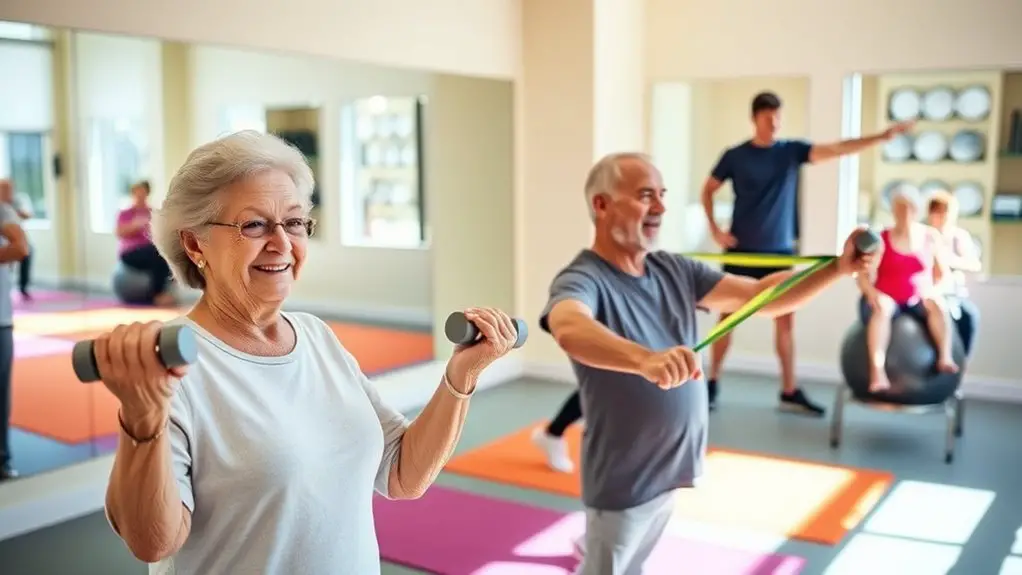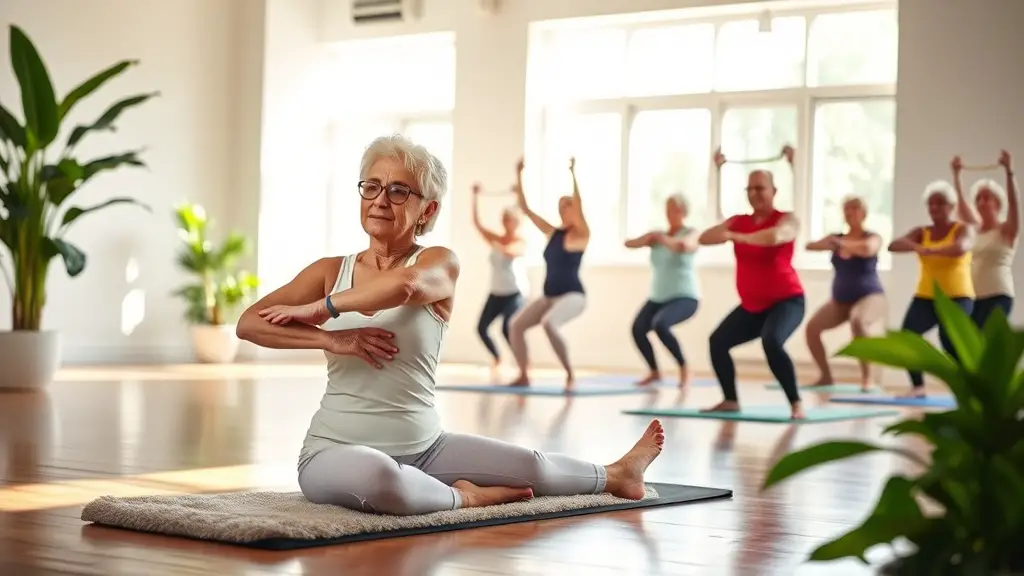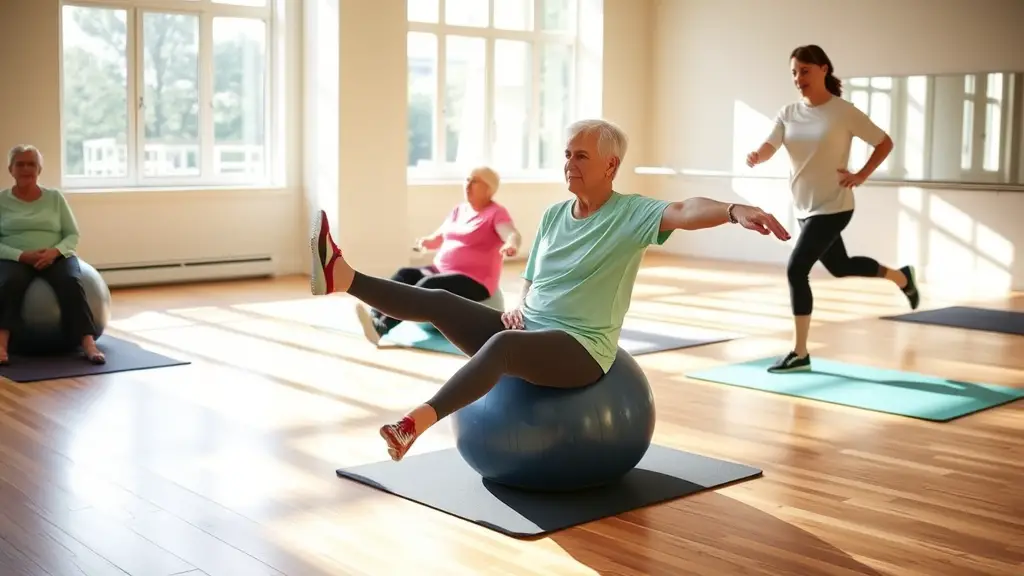The Best Gym Exercises for Seniors to Maintain Strength

Strength training is essential for you as a senior to maintain your health and muscle mass. Incorporate exercises like seated rows, wall push-ups, and squats into your routine, aiming for at least two sessions a week. Don’t forget to warm up with arm circles and leg swings to prevent injury. Focus on balance with single-leg stands and heel-to-toe walks. By following safe practices, you’ll enhance your strength and stability. Discover more important exercises to boost your fitness!
Importance of Strength Training for Seniors

As you age, maintaining strength becomes essential for your overall health and well-being. Strength training plays a vital role in muscle preservation, which helps combat the natural decline in muscle mass that occurs with aging. By engaging in regular strength exercises, you can enhance your functional fitness, making everyday activities like climbing stairs or lifting groceries easier and safer.
Incorporating strength training into your routine doesn’t have to be intimidating. Simple exercises using resistance bands, free weights, or even your body weight can be highly effective. Aim for at least two sessions a week, focusing on major muscle groups.
Warm-Up Exercises to Prepare the Body
Before diving into your workout, it’s important to warm up your body to prepare your muscles and joints for exercise. A proper warm-up not only enhances performance but also reduces the risk of injury. Incorporate these gentle movements into your routine:
- Arm Circles: Stand tall and extend your arms out to the sides. Rotate them in small circles, gradually increasing the size. This dynamic stretch warms up your shoulders and improves mobility.
- Leg Swings: Hold onto a wall for support and swing one leg forward and backward. This engages your hips and helps with balance, making your workout safer.
- Torso Twists: Stand with your feet shoulder-width apart. Gently twist your torso from side to side. This dynamic stretch warms up your spine and prepares your core for activity.
Resistance Training: Key Exercises for Building Strength

Resistance training is an essential component of any fitness routine, especially for seniors looking to build strength and maintain independence. Incorporating resistance bands and bodyweight exercises can be highly effective and safe. Here are some key exercises to take into account:
| Exercise | Equipment | Reps/Duration |
|---|---|---|
| Seated Row | Resistance Bands | 10-15 reps |
| Wall Push-Ups | Bodyweight | 8-12 reps |
| Squats | Bodyweight | 10-15 reps |
| Resistance Band Bicep Curls | Resistance Bands | 10-15 reps |
These exercises not only enhance muscle strength but also improve overall mobility. Start with lighter resistance and focus on form. As you gain confidence, gradually increase intensity. Remember, it’s always a good idea to consult a trainer or healthcare provider before starting any new exercise regimen. Stay strong and enjoy the benefits!
Balance and Stability Exercises for Seniors
Building strength is important, but it’s equally essential to focus on balance and stability as you age. Enhancing your balance can help prevent falls and improve your overall confidence. Here are three effective balance techniques and stability drills you can incorporate into your routine:
As you age, prioritizing balance and stability is crucial for fall prevention and confidence.
- Single-leg stands: Stand on one leg for 10-30 seconds, then switch. This simple exercise strengthens your ankle and improves stability.
- Heel-to-toe walk: Walk in a straight line, placing the heel of one foot directly in front of the toes of the other. This helps refine your coordination and balance.
- Side leg raises: Stand and lift one leg to the side, holding for a few seconds before lowering. This targets your hip muscles, enhancing stability.
Flexibility and Stretching Routines

Flexibility is essential for maintaining mobility and preventing injuries as you age. Incorporating effective stretching techniques into your routine can greatly enhance your overall well-being. Let’s explore safe stretching practices that you can easily integrate into your workouts.
Importance of Flexibility
Staying limber is essential for maintaining your overall health and mobility as you age. Embracing flexibility can greatly enhance your quality of life. Here are some key flexibility benefits to reflect on:
- Increased Mobility: You’ll find it easier to perform daily activities, from bending to tie your shoes to reaching for items on a shelf.
- Reduced Injury Risk: Regular stretching helps prevent injuries by improving your range of motion and strengthening your muscles.
- Enhanced Balance: Good flexibility contributes to better balance, which is critical in preventing falls.
Understanding the stretching significance in your routine can lead to a healthier, more active lifestyle. So, don’t overlook the power of flexibility; it’s an essential component of staying strong and independent as you age.
Effective Stretching Techniques
While incorporating effective stretching techniques into your routine might seem intimidating, it’s a simple yet powerful way to enhance your flexibility and overall well-being. Start with dynamic stretching before your workouts; these movements, like leg swings and arm circles, warm up your muscles and get your blood flowing. They prepare your body for exercise by improving range of motion. After your workout, incorporate static stretching, where you hold a stretch for 15-30 seconds. This type of stretching helps lengthen your muscles and improve flexibility. Focus on major muscle groups, such as hamstrings, quadriceps, and shoulders. Remember to breathe deeply and never push into pain. By making stretching a habit, you’ll feel more agile and reduce the risk of injury.
Safe Stretching Practices
Incorporating safe stretching practices into your routine can markedly enhance your flexibility and overall fitness level. It’s crucial to know the difference between dynamic and static stretching. Here are some tips to keep in mind:
- Warm Up First: Always start with a light warm-up to prepare your muscles for stretching.
- Listen to Your Body: If you feel pain while stretching, ease off. Stretching should feel good, not painful.
- Hold Static Stretches: For static stretching, hold each stretch for about 15-30 seconds to effectively improve flexibility.
Tips for Staying Safe While Exercising

To guarantee a safe and enjoyable workout experience, it’s essential to keep a few key tips in mind. First, always warm up before diving into your routine; it helps prepare your muscles and reduces the risk of injury. When choosing exercises, stick to those that match your current fitness level, and don’t hesitate to ask for guidance from trainers. Remember to listen to your body—if something doesn’t feel right, stop immediately. Staying hydrated is another important exercise precaution; dehydration can lead to dizziness and fatigue. Also, consider using proper equipment to secure stability and support, especially if you’re trying new exercises. Finally, make sure to cool down and stretch after your workout to aid recovery. By following these tips, you’ll promote injury prevention and create a safe environment for your fitness journey. Additionally, it’s important to consult a doctor before starting any new workout routine. Enjoy your time at the gym and keep pushing yourself!
Frequently Asked Questions
How Often Should Seniors Strength Train Each Week?
You should aim for strength training at least two to three times a week. This frequency allows your muscles to strengthen while giving them adequate time for workout recovery. It’s important to listen to your body; if you’re feeling fatigued, don’t hesitate to take an extra rest day. By maintaining a consistent routine, you’ll build strength safely and effectively, enhancing your overall health and well-being. Keep it enjoyable and stay motivated!
What Equipment Is Best for Seniors at the Gym?
When you’re at the gym, choosing the right equipment can make all the difference. Resistance bands are fantastic for building strength while being gentle on your joints. They’re versatile and easy to adjust for different fitness levels. Exercise machines are also a great option, as they provide support and guided movement, helping you focus on your form. Always prioritize safety and comfort, and don’t hesitate to ask trainers for assistance if you need it!
Can Seniors Exercise With Chronic Health Conditions?
Absolutely, you can exercise with chronic conditions! It’s like riding a bike; once you get started, it can become second nature. Just remember to consult your doctor first. Safe modifications are key; low-impact activities like swimming or cycling can be great options. Listen to your body, and adjust as needed. Staying active can improve your health and well-being, so don’t hesitate to explore what works best for you!
How Do I Track My Progress in Strength Training?
Tracking your progress in strength training is essential for staying motivated and safe. Start by setting specific strength benchmarks, like how much weight you can lift or the number of reps you can complete. Regularly note your progress measurements in a journal or app. Celebrate small victories, and don’t hesitate to adjust your goals as you improve. This way, you’ll stay focused and committed to your strength training journey while ensuring you’re exercising safely.
What Are Signs of Overexertion for Seniors During Workouts?
When you push yourself too hard, it’s like running a marathon without training—your body’s bound to protest. Look out for fatigue signs, such as excessive tiredness or sore muscles that linger longer than usual. If you notice balance issues, like unsteadiness or difficulty in maintaining your posture, it’s time to take a step back. Always listen to your body; adjusting your routine guarantees you stay safe and strong while enjoying your workouts.





